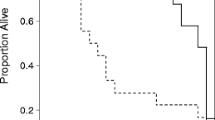Abstract
The ability of natural enemies to reproduce within cropland and effectively suppress pests depends on the presence of plants on which to oviposit within the agroecosystems. Our research investigates the acceptability and preferences of a range of plants for oviposition by the predatory bug Orius insidiosus (Say) (Hemiptera: Anthocoridae) in the laboratory. Within-plant preferences on pole beans as oviposition sites were evaluated in laboratory choice tests. The acceptability and preference of O. insidiosus females for pole bean, soybean, redroot pigweed, and velvetleaf were evaluated in choice and no-choice tests (respectively) in the laboratory. Observations on the acceptability of green foxtail, orchardgrass, buffalograss, smooth brome, redtop grass, blue grama, and tall fescue for oviposition were also conducted. O. insidiosus preferred to lay its eggs on the petiole and leaflet petioles of pole beans, and did not distinguish among nodes or petioles of different lengths. Although all broadleaved plants were suitable for egg development, the acceptability of these plants differed significantly, with pole beans being most acceptable and almost no eggs being laid on velvetleaf. Preference tests supported the results of the no-choice tests, with pole bean being the most preferred, and no eggs being laid on the velvetleaf. Green foxtail and orchardgrass were the only grass species found to be acceptable to O. insidiosus. The implications of soybean monocultures on the reproductive capacity of and biological control by O. insidiosus are discussed, as are possible mechanisms underlying the decision-making process for oviposition.
Similar content being viewed by others
References
N.H. Anderson (1962) ArticleTitleAnthocoridae of the Pacific Northwest with notes on distributions, life histories, and habits (Heteroptera) Can. Entomol. 94 1325–1334 Occurrence Handle10.4039/Ent941325-12
D.A. Andow (1991) ArticleTitleVegetational diversity and arthropod population response Annu. Rev. Entomol. 36 561–586 Occurrence Handle10.1146/annurev.en.36.010191.003021
InstitutionalAuthorNameAnonymous (1997) How a Soybean Plant Develops Iowa State University Cooperative Extension Service Ames
C.A. Armer R.N. Wiedenmann D.R. Bush (1998) ArticleTitlePlant feeding site selection on soybean by the facultatively phytophagous predator Orius insidiosus Entomol. Exp. et Appl. 86 109–118 Occurrence Handle10.1023/A:1003168909489
C.A. Armer R.N. Wiedenmann M.E. Irwin (1999) ArticleTitleEffects of soybean mosaic virus on the facultative phytophagous predator Orius insidiosus (Heteroptera: Anthocoridae) Environ. Entomol. 28 1036–1043
A. Askari V.M. Stern (1972) ArticleTitleBiology and feeding habits of Orius tristicolor (Hemiptera: Anthocoridae) Ann. Entomol. Soc. Am. 65 96–100
G.W. Barber (1936) ArticleTitleOrius insidiosus (Say), an important natural enemy of the corn earworm USDA Tech. Bull. 504 1–22
R.L. Bugg C. Waddington (1994) ArticleTitleUsing cover crops to manage arthropod pests of orchards: a review Agr., Ecosyst. Environ. 50 11–28 Occurrence Handle10.1016/0167-8809(94)90121-X
C. Castañé F.G. Zalom (1994) ArticleTitleArtificial oviposition substrate for rearing Orius insidiosus (Hemiptera: Anthocoridae) Biol. Control 4 88–91 Occurrence Handle10.1006/bcon.1994.1015
D. Coderre L. Provencher J.C. Tourneur (1987) ArticleTitleOviposition and niche partitioning in aphidophagous insects on maize Can. Entomol. 119 195–203
M. Coll (1996) ArticleTitleFeeding and ovipositing on plants by an omnivorous insect predator Oecologia 105 214–220
T.E. Cottrell K.V. Yeargan (1998) ArticleTitleInfluence of a native weed, Acalypha ostryaefolia (Euphorbiaceae), on Coleomegilla maculata (Coleoptera: Coccinellidae) population density, predation, and cannibalism in sweet corn Environ. Entomol. 27 1375–1385
T.E. Cottrell K.V. Yeargan (1999) ArticleTitleFactors influencing the dispersal of larval Coleomegilla maculata from the weed Acalypha ostryaefolia to sweet corn Entomol. Exp. et Appl. 90 313–322 Occurrence Handle10.1023/A:1026429217088
T.B. Fox D.A. Landis F.F. Cardoso C.D. DiFonzo (2004) ArticleTitlePredators suppress Aphis glycines Matsumura population growth in soybean Environ. Entomol. 33 608–618
M.L. Griffin K.V. Yeargan (2002a) ArticleTitleOviposition site selection by the spotted lady beetle, Coleomegilla maculata (Coleoptera: Coccinellidae): choices among plant species Environ. Entomol. 31 107–111 Occurrence Handle10.1603/0046-225X-31.1.107
M.L. Griffin K.V. Yeargan (2002b) ArticleTitleFactors potentially affecting oviposition site selection by the spotted lady beetle Coleomegilla maculata (Coleoptera: Coccinellidae) Environ. Entomol. 31 112–119
J.Y. Guo F.H. Wan (2001) ArticleTitleUse of Kalanchoe blossfeldiana as oviposition plant for mass-rearing Orius sauteri (Hemiptera: Anthocoridae) Chin. J. Biol. Control 17 53–56
D.J. Isenhour K.V. Yeargan (1981) ArticleTitleEffect of temperature on the development of Orius insidiosus with notes on laboratory rearing Ann. Entomol. Soc. Am. 74 114–116
D.J. Isenhour K.V. Yeargan (1982) ArticleTitleOviposition sites of Orius insidiosus (Say) and Nabis spp. in soybean (Hemiptera: Anthocoridae) J. Kansas Entomol. Soc. 55 65–72
D.A. Landis S.D. Wratten G.M. Gurr (2000) ArticleTitleHabitat management to conserve natural enemies of arthropod pests in agriculture Annu. Rev. Entomol. 45 175–201 Occurrence Handle10.1146/annurev.ento.45.1.175 Occurrence Handle1:CAS:528:DC%2BD3cXisVequ7w%3D Occurrence Handle10761575
E. Lucas J. Brodeur (1999) ArticleTitleOviposition site selection by the predatory midge Aphidoletes aphidimyza (Diptera: Cecidomyiidae) Environ. Entomol. 28 622–627
R.F. Norris M. Kogan (2000) ArticleTitleInteractions between weeds, arthropod pests, and their natural enemies in managed ecosystems Weed Sci. 48 94–158 Occurrence Handle1:CAS:528:DC%2BD3cXhvVektLw%3D
P.C. Richards J.M. Schmidt (1996) ArticleTitleThe suitability of some natural and artificial substrates as oviposition sites for the insidious flower bug, Orius insidiosus Entomol. Exp. et Appl. 80 325–333 Occurrence Handle10.1007/BF00188025
J.R. Ruberson L. Bush T.J. Kring (1991) ArticleTitlePhotoperiodic effect on diapause induction and development in the predator Orius insidiosus (Heteroptera: Anthocoridae) Environ. Entomol. 20 786–789
C.E. Rutledge R.J. O’Neil T.B. Fox D.A. Landis (2004) ArticleTitleSoybean aphid predators and their use in integrated pest management Ann. Entomol. Soc. Am. 97 240–248
L. Shaltiel M. Coll (2004) ArticleTitleReduction of pear psylla damage by the predatory bug, Anthocoris nemoralis (Hemiptera: Anthocoridae): the importance of orchard colonization time and neighboring vegetation Biocontrol Sci. Tech. 14 811–821 Occurrence Handle10.1080/09583150410001720662
InstitutionalAuthorNameSYSTAT Software Inc. (2004) SYSTAT 11 owner’s manual SYSTAT Software Inc. Richmond, CA
Author information
Authors and Affiliations
Corresponding author
Rights and permissions
About this article
Cite this article
Lundgren, J.G., Fergen, J.K. The Oviposition Behavior of the Predator Orius insidiosus: Acceptability and Preference for Different Plants. Biocontrol 51, 217–227 (2006). https://doi.org/10.1007/s10526-005-0609-2
Received:
Accepted:
Issue Date:
DOI: https://doi.org/10.1007/s10526-005-0609-2




